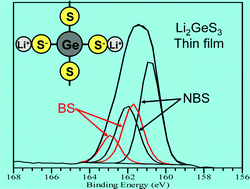In this study, the compositions of and chemical speciation in lithium thio-germanate thin films grown by radio frequency (RF) magnetron sputtering were determined by means of X-ray photoelectron spectroscopy (XPS). Three different targets, nLi2S + GeS2 (n = 1, 2, and 3) for RF sputtering were prepared. Thin films of ∼1 μm thickness were grown on single crystal Si [111] substrates using 50 W power and ∼3.3 Pa Ar gas atmospheres. As is commonly observed for RF sputtered non-oxide films, the surfaces of these lithium thio-germanate films were contaminated with both C and O at ∼10 at %. Etching the top surface of the films with Ar removed all of the surface carbon and reduced the oxygen contamination down to an average value of ∼5 at %. After such surface etching, the compositions of the films were found to agree very closely with the nominal composition of the target from which it was made. The Li2GeS3 (n = 1) thin film was found as expected to exhibit a 2 : 1 non-bridging sulfur (![[triple bond, length as m-dash]](https://www.rsc.org/images/entities/char_e002.gif) Ge–S−Li+, NBS) to bridging sulfur (
Ge–S−Li+, NBS) to bridging sulfur (![[triple bond, length as m-dash]](https://www.rsc.org/images/entities/char_e002.gif) Ge–S–Ge
Ge–S–Ge![[triple bond, length as m-dash]](https://www.rsc.org/images/entities/char_e002.gif) , BS) ratio. As the Li2S content increased, the Li4GeS4 and Li6GeS5 thin films, n = 2 and 3, exhibited as expected, 100% NBS. For the S2p core peaks, the binding energy of S in GeS2 is the highest due to the nearly covalent bonding in the BS structure,
, BS) ratio. As the Li2S content increased, the Li4GeS4 and Li6GeS5 thin films, n = 2 and 3, exhibited as expected, 100% NBS. For the S2p core peaks, the binding energy of S in GeS2 is the highest due to the nearly covalent bonding in the BS structure, ![[triple bond, length as m-dash]](https://www.rsc.org/images/entities/char_e002.gif) Ge–S–Ge
Ge–S–Ge![[triple bond, length as m-dash]](https://www.rsc.org/images/entities/char_e002.gif) . As the Li2S content increased, the binding energy of S in the thin films progressively decreased due to the progressive increase in the fraction (and number) of NBS (more ionic),
. As the Li2S content increased, the binding energy of S in the thin films progressively decreased due to the progressive increase in the fraction (and number) of NBS (more ionic), ![[triple bond, length as m-dash]](https://www.rsc.org/images/entities/char_e002.gif) Ge–S−Li+, in the films.
Ge–S−Li+, in the films.
![[triple bond, length as m-dash]](https://www.rsc.org/images/entities/char_e002.gif) Ge–S−Li+, NBS) to bridging sulfur (
Ge–S−Li+, NBS) to bridging sulfur (![[triple bond, length as m-dash]](https://www.rsc.org/images/entities/char_e002.gif) Ge–S–Ge
Ge–S–Ge![[triple bond, length as m-dash]](https://www.rsc.org/images/entities/char_e002.gif) ,
, ![[triple bond, length as m-dash]](https://www.rsc.org/images/entities/char_e002.gif) Ge–S–Ge
Ge–S–Ge![[triple bond, length as m-dash]](https://www.rsc.org/images/entities/char_e002.gif) . As the Li2S content increased, the binding energy of S in the thin films progressively decreased due to the progressive increase in the fraction (and number) of NBS (more ionic),
. As the Li2S content increased, the binding energy of S in the thin films progressively decreased due to the progressive increase in the fraction (and number) of NBS (more ionic), ![[triple bond, length as m-dash]](https://www.rsc.org/images/entities/char_e002.gif) Ge–S−Li+, in the films.
Ge–S−Li+, in the films.

 Please wait while we load your content...
Please wait while we load your content...